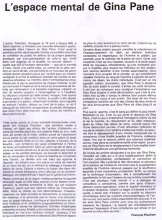Creator:
Gina Pane
Performer:
Gina Pane
Bibliographical sources:
cité in catalogue Gina Pane, Cadran solaire, Troyes, 1991, p. 139
Producer:
Gina Pane
Occurence:
Places:
Starting date:
04 19 1973
Topology:
Adress:
Saint Jeannet
FranceObjets:
constat d'action : 6 photographies montées sur panneau signé et commenté
Technique description référence:
constat d'action : 6 photographies montées sur panneau signé et commenté
Documents:
L'espace mental de Gina Pane
Type:
Imprimé
Technique description référence:
compte rendu de l'action par François Pluchard, in <em>Artitudes n° 5</em>, été 1973, pp. 16-19


 ''
''